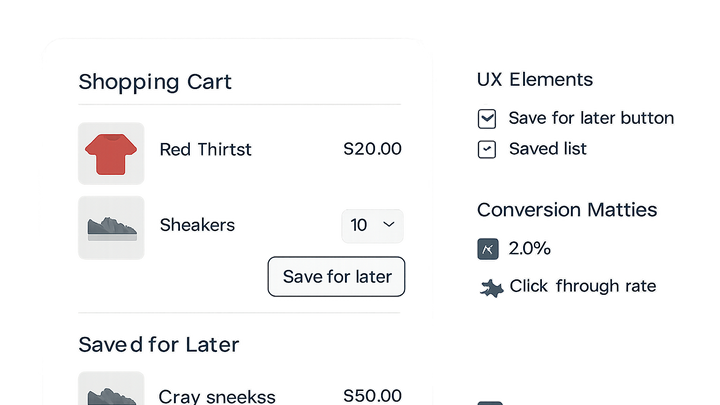Published on 2025-06-29T22:05:57Z
What is Checkout Save for Later? Examples and Best Practices
Checkout Save for Later is a feature in e-commerce and UX design that lets shoppers temporarily remove items from their cart and store them for a future purchase. It reduces friction in the checkout journey by giving users flexibility to revisit decisions, which can lead to lower cart abandonment rates and higher conversion rates. From a CRO perspective, it captures intent without forcing an immediate commitment, providing valuable lead-generation opportunities when paired with email captures or remarketing strategies. In UX, it enhances user satisfaction by reducing decision fatigue and supporting better inventory management. SEO benefits can emerge indirectly through improved engagement metrics and lower bounce rates, signaling a positive user experience to search engines. Accessibility considerations, such as clear ARIA labels and keyboard navigation, ensure that the Save for Later feature is inclusive. Tools like Prevue.me can offer actionable critiques—evaluating clarity, CTA prominence, performance, and accessibility—to continuously optimize this functionality.
Checkout save for later
A UX feature allowing shoppers to save cart items for later, reducing abandonment and boosting conversions.
Understanding Checkout Save for Later
This section explores the core concept of Checkout Save for Later, its role in e-commerce flows, and why it matters for conversion optimization and user experience.
-
Definition
Checkout Save for Later allows users to remove items from their active shopping cart and store them in a separate list for future purchase without losing their selections.
-
Purpose in cro and ux
It balances immediate sales pressure with user autonomy, reducing cart abandonment and building trust by acknowledging that shoppers may need time to decide.
Benefits and Impact
Outline the measurable advantages of implementing Checkout Save for Later, including its effects on abandonment rates, user satisfaction, and revenue.
-
Reducing cart abandonment
By offering a less final action than removal, it keeps potential purchases within reach, leading to a lower abandonment rate.
-
Enhancing user experience
Gives shoppers control over their cart, reducing cognitive load and decision fatigue, which improves overall satisfaction.
-
Boosting conversions
Saved items can trigger targeted email reminders or retargeting campaigns, converting intent into completed transactions.
Best Practices for Implementation
Key considerations to ensure the Save for Later feature delivers maximum value without introducing new friction.
-
Design best practices
Position the Save for Later option clearly near cart items, use concise labels, and provide immediate visual feedback on interaction.
- Clear labeling:
Use straightforward CTAs like ‘Save for later’ to avoid ambiguity.
- Visual feedback:
Show confirmation (e.g., animations or toast messages) to assure users their action was successful.
- Clear labeling:
-
Technical requirements
Decide between server-side and client-side storage to balance persistence and performance.
- Server-side storage:
Persist saved items in the user profile or account database for cross-device access.
- Client-side storage:
Use cookies or localStorage for guest users, ensuring data is synced when they log in.
- Server-side storage:
-
Seo and performance considerations
Ensure saving actions do not generate crawlable URLs or duplicate content and optimize code for minimal performance impact.
Examples with Prevue.me
How prevue.me can audit and optimize your Checkout Save for Later implementation across CRO, UX, SEO, and accessibility dimensions.
-
Ux critiques
prevue.me analyzes the save button’s visibility, labeling, and ease of use on desktop and mobile interfaces.
-
Cro insights
Identifies friction points in the save flow and offers actionable recommendations to increase save rates and eventual conversions.
-
Accessibility evaluation
Checks keyboard navigation, ARIA announcements, and screen reader compatibility for the Save for Later feature.
